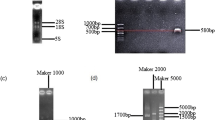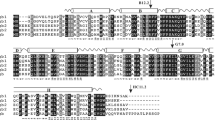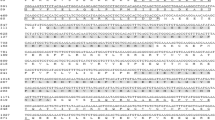Abstract
The connective tissue growth factor gene plays important role in several biological processes and also responsive to hypoxia stress in fishes. The freshwater fish, Labeo rohita, highly cultured in Indian subcontinent for food, is reported as hypoxia sensitive but annotation and sequences of nuclear genes were not available for this species so far in the public domain, except some transcripts. In this study, an attempt was made for isolation and annotation of the CTGF gene in L. rohita using information of zebrafish from the same family. The CTGF gene sequence was obtained by aligning assembled genome of L. rohita, (NCBI BioProject ID: PRJNA437789), with the CTGF protein of zebrafish. Eight overlapping sets of forward and reverse primers from aligned region were designed for amplification of around 600 bp long successive overlapping fragments of CTGF gene in L. rohita. Assembly and annotation of overlapping fragments confirmed a complete 2421 bp long CTGF gene sequence with a full coding region that comprised of five exons between 308 and 1921 positions. This annotated CTGF gene sequence was submitted to GenBank (Acc. No. KY940466). Characterization of CTGF will be an initiative in identification of hypoxia response genes in L. rohita which may further help in understanding the mechanism of hypoxia tolerability in this species.





Similar content being viewed by others
Abbreviations
- CTGF:
-
Connective tissue growth factor
- HAS:
-
Hypoxia ancillary sequence
- HIF:
-
Hypoxia inducible factors
- HRE:
-
Hypoxia response element
- TSS:
-
Transcription start site
References
Brahimi-Horn MC, Pouysségur J (2007) Oxygen, a source of life and stress. FEBS Lett 581:3582–3591
Michiels C (2004) Physiological and pathological responses to hypoxia. Am J Pathol 164:1875–1882
Diaz R, Rosenberg R (1995) Marine benthic hypoxia: a review of its ecological effects and the behavioral responses of benthic macro fauna. Oceanogr Mar Biol Annu Rev 33:245–303
Smith VH, Tilman GD, Nekola JC (1999) Eutrophication: impacts of excess nutrient inputs on freshwater, marine, and terrestrial ecosystems. Environ Pollut 100:179–196
Obenour DR, Michalak AM, Zhou Y, Scavia D (2012) Quantifying the impacts of stratification and nutrient loading on hypoxia in the northern Gulf of Mexico. Environ Sci Technol 46:5489–5496
McBryan TL, Anttila K, Healy TM, Schulte PM (2013) Responses to temperature and hypoxia as interacting stressors in fish: implications for adaptation to environmental change. Integr Comp Biol 53:648–659
Whitworth KL, Baldwin DS, Kerr JL (2012) Drought, floods and water quality: Drivers of a severe hypoxic blackwater event in a major river system (the southern Murray–Darling Basin, Australia). J Hydrol 450–451, 190–198
Padmavathy P, Ramanathan N, Francis T (2003) Glucose, lactate and pyruvate metabolism in Labeo rohita with reference to ambient oxygen. Asian Fish Sci 16:51–58
Singh SP, Sharma J, Ahmad T, Chakrabarti R (2016) Oxygen stress: impact on innate immune system, antioxidant defence system and expression of HIF-1α and ATPase 6 genes in Catla catla. Fish Physiol Biochem 42:673–688
Basu M, Paichha M, Lenka SS, Chakrabarty R, Samanta M (2016) Hypoxic stress: impact on the modulation of TLR2, TLR4, NOD1 and NOD2 receptor and their down-stream signalling genes expression in catla (Catla catla). Mol Biol Rep 43:1–9
Varghese T, Pal AK, Mishal P, Sahu NP, Dasgupta S (2017) Physiological and molecular responses of a bottom dwelling carp, Cirrhinus mrigala to short-term environmental hypoxia. Tur J Fish Aqua Sci 18:483–490
Froese R, Pauly D (2017) FishBase. World Wide Web electronic publication. http://www.fishbase.org, version (June 2017)
Khan MA, Jafri AK, Chadha NK (2004) Growth and body composition of rohu, Labeo rohita (Hamilton), fed compound diet: winter feeding and rearing to marketable size. J Appl Ichthyol 20:265–270
Jena JK (2006) Cultured aquatic species information programme. Labeo rohita. FAO Fisheries and Aquaculture Department [online]. Rome. Updated 21 February 2006. [Cited 20 December 2018]
Das S, Chhottaray C, Das Mahapatra K, Saha JN, Baranski M, Robinson N, Sahoo PK (2014) Analysis of immune-related ESTs and differential expression analysis of few important genes in lines of rohu (Labeo rohita) selected for resistance and susceptibility to Aeromonas hydrophila infection. Mol Biol Rep 41(11):7361–7371
Nagpure NS, Rashid I, Pathak AK, Singh M, Singh SP, Sarkar UK (2012) Computational analysis of transcriptome of Indian major carp, Labeo rohita (Hamilton-Buchanan, functional annotation. Bioinformation 8(21):1005–1011
Robinson N, Sahoo PK, Baranski M, Das Mahapatra K, Saha JN, Das S, Mishra Y, Das P, Barman HK, Eknath AE (2012) Expressed sequences and polymorphisms in rohu carp (Labeo rohita, Hamilton) revealed by mRNA-sEq. Mar Biotechnol (NY) 14(5):620–633
Rashid I, Nagpure NS, Srivastavak P, Kumar R, Pathak AK, Singh M, Kushwaha B (2017) HRGFish: a database of hypoxia responsive genes in fishes. Sci Rep 7:42346
Wang X, Gan X, Li J, Mayden RL, He S (2012) Cyprinid phylogeny based on Bayesian and maximum likelihood analyses of partitioned data: implications for Cyprinidae systematics. Sci China Life Sci 55:761–773
Moussad EE, Brigstock DR (2000) Connective tissue growth factor: what’s in a name? Mol Genet Metab 71:276–292
Wang Y, Li FG, Qin B, Chen J, Jiang XY, Zou SM (2015) Duplicated connective tissue growth factor genes in hypoxia-sensitive blunt snout bream Megalobrama amblycephala and their in vivo expression. Comp Biochem Physiol B Biochem Mol Biol 181:42–49
Higgins DF, Biju MP, Akai Y, Wutz A, Johnson RS, Haase VH (2004) Hypoxic induction of CTGF is directly mediated by Hif-1. Am J Physiol Renal Physiol 287:F1223–F1232
Rytkönen KT, Akbarzadeh A, Miandare HK, Kamei H, Duan C, Leder EH, Williams TA, Nikinmaa M (2013) Sub functionalization of cyprinid hypoxia-inducible factors for roles in development and oxygen sensing. Evolution 67:873–882
Wenger RH, Stiehl DP, Camenisch G (2005) Integration of oxygen signaling at the consensus HRE. Sci STKE 2005(306):re12
Kroening S, Neubauer E, Wullich B, Aten J, Goppelt-Struebe M (2010) Characterization of connective tissue growth factor expression in primary cultures of human tubular epithelial cells: modulation by hypoxia. Am J Physiol Renal Physiol 298:F796–F806
Wu W, Li J, Zhao M, Liu X (2017) HIF-1α mediates visfatin-induced CTGF expression in vascular endothelial cells. Cell Mol Biol (Noisy-le-grand) 63:28–32
Ruzzante DE, Taggart CT, Cook D (1996) Spatial and temporal variation in the genetic composition of a larval cod (Gadus morhua) aggregation: cohort contribution and genetic stability. Can J Fish Aquat Sci 53:2695–2705
Faber-Hammond JJ, Brown KH (2016) Pseudo-de novo assembly and analysis of unmapped genome sequence reads in wild Zebrafish reveal novel gene content. Zebrafish 13:95–102
Howe K, Clark MD, Torroja CF, Torrance J, Berthelot C, Muffato M, Collins JE et al (2013) The zebrafish reference genome sequence and its relationship to the human genome. Nature 496:498–503
Altschul SF, Madden TL, Schäffer AA, Zhang J, Zhang Z, Miller W, Lipman DJ (1997) Gapped BLAST and PSI-BLAST: a new generation of protein database search programs. Nucleic Acids Res 25:3389–3402
Ye J, Coulouris G, Zaretskaya I, Cutcutache I, Rozen S, Madden TL (2012) Primer-BLAST: a tool to design target-specific primers for polymerase chain reaction. BMC Bioinform 13:134
Ho SN, Hunt HD, Horton RM, Pullen JK, Pease LR (1989) Site-directed mutagenesis by overlap extension using the polymerase chain reaction. Gene 77:51–59
Sanger F, Nicklen S, Coulson AR (1977) DNA sequencing with chain-terminating inhibitors. Proc Natl Acad Sci USA 74:5463–5467
Larkin MA, Blackshields G, Brown NP, Chenna R, McGettigan PA, McWilliam H et al (2007) Clustal W and Clustal X version 2.0. Bioinformatics 23:2947–2948
Huang X, Madan A (1999) CAP3: a DNA sequence assembly program. Genome Res 9:868–877
Solovyev V, Kosarev P, Seledsov I, Vorobyev D (2006) Automatic annotation of eukaryotic genes, pseudogenes and promoters. Genome Biol S10:1–12
Stanke M, Steinkamp R, Waack S, Morgenstern B (2004) AUGUSTUS: a web server for gene finding in eukaryotes. Nucleic Acids Res 32:W309–W312
Tamura K, Peterson D, Peterson N, Stecher G, Nei M, Kumar S. 2011.MEGA5: molecular evolutionary genetics analysis using maximum likelihood,evolutionary distance, and maximum parsimony methods. MolBiolEvol. 28:2731–2739
Letunic I, Bork P (2016) Interactive tree of life (iTOL) v3: an online tool for the display and annotation of phylogenetic and other trees. Nucleic Acids Res 44:W242–W245
Machanick P, Bailey TL (2011) MEME-ChIP: motif analysis of large DNA datasets. Bioinformatics 27:1696–1697
Higuchi R, Krummel B, Saiki RK (1988) A general method of in vitro preparation and specific mutagenesis of DNA fragments: study of protein and DNA interactions. Nucleic Acids Res 16:7351–7367
Heckman KL, Pease LR (2007) Gene splicing and mutagenesis by PCR-driven overlap extension. Nat Protoc 2:924–932
Ratnasingham S, Hebert PD (2007) BOLD: the barcode of life data system. Mol Ecol Notes 7:355–364. http://www.barcodinglife.org
Fernando CA, Conrad PA, Bartels CF, Marques T, To M, Balow SA, Nakamura Y, Warman ML (2010) Temporal and spatial expression of CCN genes in zebrafish. Dev Dyn 239:1755–1767
Greenald D, Jeyakani J, Pelster B, Sealy I, Mathavan S, van Eeden FJ (2015) Genome-wide mapping of Hif-1α binding sites in zebrafish. BMC Genom 16:923
Schödel J, Oikonomopoulos S, Ragoussis J, Pugh CW, Ratcliffe PJ, Mole DR (2011) High-resolution genome-wide mapping of HIF-binding sites by ChIP-sEq. Blood 117:e207–e217
Kajimura S, Aida K, Duan C (2006) Understanding hypoxia-induced gene expression in early development: in vitro and in vivo analysis of hypoxia-inducible factor 1-regulated zebra fish insulin-like growth factor binding protein 1 gene expression. Mol Cell Biol 26:1142–1155
Kimura H, Weisz A, Ogura T, Hitomi Y, Kurashima Y, Hashimoto K, D’Acquisto F, Makuuchi M, Esumi H (2001) Identification of hypoxia-inducible factor 1 ancillary sequence and its function in vascular endothelial growth factor gene induction by hypoxia and nitric oxide. J Biol Chem 276:2292–2298
Kulkarni RP, Tohari S, Ho A, Brenner S, Venkatesh B (2010) Characterization of a hypoxia-response element in the Epo locus of the pufferfish, Takifugu rubripes. Mar Genomics 3:63–70
Acknowledgements
Authors are thankful to the Director, ICAR-NBFGR, Lucknow, for providing necessary facilities to carry out this work. Authors are also thankful to the CABin Scheme of ICAR and CABin Division of ICAR-IASRI, New Delhi, for financial assistance and guidance. First author is thankful to Dr. Satarudra Prakash Singh and Dr. Vineet Awasthi, Amity University Uttar Pradesh, Lucknow, for their continued suggestions.
Author information
Authors and Affiliations
Corresponding author
Ethics declarations
Conflict of interest
The authors declare no conflict of interest.
Additional information
Publisher’s Note
Springer Nature remains neutral with regard to jurisdictional claims in published maps and institutional affiliations.
Rights and permissions
About this article
Cite this article
Rashid, I., Baisvar, V.S., Singh, M. et al. Isolation and characterization of hypoxia inducible gene connective tissue growth factor (CTGF) in Labeo rohita. Mol Biol Rep 46, 1683–1691 (2019). https://doi.org/10.1007/s11033-019-04617-w
Received:
Accepted:
Published:
Issue Date:
DOI: https://doi.org/10.1007/s11033-019-04617-w




